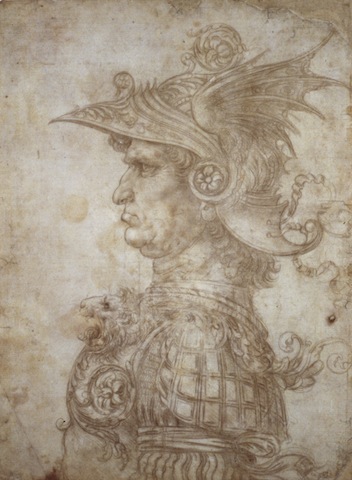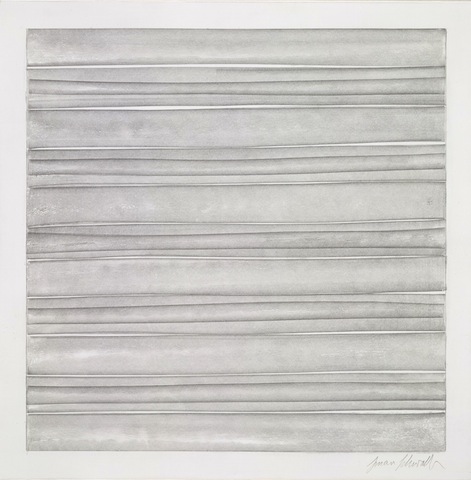Drawing in Silver and Gold: Leonardo to Jasper Johns, British Museum | reviews, news & interviews
Drawing in Silver and Gold: Leonardo to Jasper Johns, British Museum
Drawing in Silver and Gold: Leonardo to Jasper Johns, British Museum
Dazzling shades of grey: virtuoso drawings explore a largely forgotten art

Unlike Venice, where colour reigned supreme among artists such as Titian and Veronese, Florence was the city where drawing – disegno – was held up as the cornerstone of the artist’s education. Think of the well-defined musculature of Michelangelo’s figures. Florentine artists of the Renaissance practiced an art of detailed precision, mastering clarity of line and structural rigour.
The British Museum’s exhibition of some 100 drawings in silverpoint and, more rarely, goldpoint, begins with a juxtaposition of hands. A pair, gracefully poised though unnaturally flexed, by the Florentine genius Leonardo, captivate the viewer by appearing almost like a relief in stone. Shaded by close crosshatching and heightened by luminous passages of white chalk, the finely modelled hands radiate a marble sheen. Next to it is a drawing that’s more of an outline sketch: four rigid, stumpy pairs of hands that look faintly arthritic by American conceptualist Bruce Nauman. They were rapidly sketched from videos of his hands performing a series of finger movements.
 There’s over 500 years between these two drawings, yet the story of silverpoint is not an uninterrupted history, and the 20th century did not see a widespread resurgence. After its flourishing in the 1400s and its rapid decline in Italy in about 1550, silverpoint only continued as a common medium in Germany and the Netherlands until the 17th century, by which time it was overtaken by graphite, a far more forgiving and versatile drawing tool. It was then partially revived in the 19th century by English artists, who included the Pre-Raphaelite Holman Hunt. These artists clearly enjoyed its relationship to the past, to the medievalist golden age of craft, since silverpoint is also associated with earlier manuscript drawing, and some of these artists were keen on using it for decorative miniatures on a range of craft surfaces.
There’s over 500 years between these two drawings, yet the story of silverpoint is not an uninterrupted history, and the 20th century did not see a widespread resurgence. After its flourishing in the 1400s and its rapid decline in Italy in about 1550, silverpoint only continued as a common medium in Germany and the Netherlands until the 17th century, by which time it was overtaken by graphite, a far more forgiving and versatile drawing tool. It was then partially revived in the 19th century by English artists, who included the Pre-Raphaelite Holman Hunt. These artists clearly enjoyed its relationship to the past, to the medievalist golden age of craft, since silverpoint is also associated with earlier manuscript drawing, and some of these artists were keen on using it for decorative miniatures on a range of craft surfaces.
With its accompanying film, the exhibition is good at explaining just what metalpoint is and how it’s used. A metal stylus will only work on paper prepared with an abrasive coating, which is usually made of animal bone ground into a paste. The sheet may then have an additional coating of paint to provide it with a light tint, perhaps a pearlescent pink or a pale sea green. In all, it’s a time-consuming process, so this suggests one other reason why the technique gradually died out. But the results can be astonishing and gorgeously ethereal, and time and again one is stopped in one’s tracks by the gossamer handiwork on display
Among the handful of works that do just that is Portrait of a Young Woman, c.1435 (main picture), the only drawing that’s ever been firmly attributed to Flemish artist Rogier van der Weyden. It’s a drawing so finely wrought, so lightly spun in soft silvery-greys, it appears at once solidly three-dimensional and barely there – an apparition whose presence nonetheless feels vivid. In contrast, the brute force of Leonardo’s soldier, Bust of a Warrior (pictured above left), c.1475, is conveyed by a very earthy presence: the jowly contours of a heavy-set, bulldog face in profile, and the extraordinary and elaborate detail of the soldier’s armour.
 It’s no wonder many of the later works, those English artists of the 19th century in particular, feel so vapid in comparison. The few drawings of the late 20th-century also seem largely flat and uninteresting, including a puzzle-drawing by Jasper Johns, where, if you look hard enough, you might find the silhouette-profiles of the Queen and Prince Philip hidden in the contours of a vase.
It’s no wonder many of the later works, those English artists of the 19th century in particular, feel so vapid in comparison. The few drawings of the late 20th-century also seem largely flat and uninteresting, including a puzzle-drawing by Jasper Johns, where, if you look hard enough, you might find the silhouette-profiles of the Queen and Prince Philip hidden in the contours of a vase.
An exception is Susan Schwalb’s Strata 407, 2005, (pictured right), an abstract drawing of gently undulating horizontal bands, whose variegated silvery tones appear to suggest subtle colours. Bright slivers of untouched white paper enhance the metallic gradations. In an exhibition that dazzles with the exquisite draughtsmanship of the Renaissance, Schwalb’s small work at least makes an impression.
Share this article
The future of Arts Journalism
You can stop theartsdesk.com closing!
We urgently need financing to survive. Our fundraising drive has thus far raised £49,000 but we need to reach £100,000 or we will be forced to close. Please contribute here: https://gofund.me/c3f6033d
And if you can forward this information to anyone who might assist, we’d be grateful.

Subscribe to theartsdesk.com
Thank you for continuing to read our work on theartsdesk.com. For unlimited access to every article in its entirety, including our archive of more than 15,000 pieces, we're asking for £5 per month or £40 per year. We feel it's a very good deal, and hope you do too.
To take a subscription now simply click here.
And if you're looking for that extra gift for a friend or family member, why not treat them to a theartsdesk.com gift subscription?
more Visual arts
 'We are bowled over!' Thank you for your messages of love and support
Much-appreciated words of commendation from readers and the cultural community
'We are bowled over!' Thank you for your messages of love and support
Much-appreciated words of commendation from readers and the cultural community
![SEX MONEY RACE RELIGION [2016] by Gilbert and George. Installation shot of Gilbert & George 21ST CENTURY PICTURES Hayward Gallery](https://theartsdesk.com/sites/default/files/styles/thumbnail/public/mastimages/Gilbert%20%26%20George_%2021ST%20CENTURY%20PICTURES.%20SEX%20MONEY%20RACE%20RELIGION%20%5B2016%5D.%20Photo_%20Mark%20Blower.%20Courtesy%20of%20the%20Gilbert%20%26%20George%20and%20the%20Hayward%20Gallery._0.jpg?itok=7tVsLyR-) Gilbert & George, 21st Century Pictures, Hayward Gallery review - brash, bright and not so beautiful
The couple's coloured photomontages shout louder than ever, causing sensory overload
Gilbert & George, 21st Century Pictures, Hayward Gallery review - brash, bright and not so beautiful
The couple's coloured photomontages shout louder than ever, causing sensory overload
 Lee Miller, Tate Britain review - an extraordinary career that remains an enigma
Fashion photographer, artist or war reporter; will the real Lee Miller please step forward?
Lee Miller, Tate Britain review - an extraordinary career that remains an enigma
Fashion photographer, artist or war reporter; will the real Lee Miller please step forward?
 Kerry James Marshall: The Histories, Royal Academy review - a triumphant celebration of blackness
Room after room of glorious paintings
Kerry James Marshall: The Histories, Royal Academy review - a triumphant celebration of blackness
Room after room of glorious paintings
 Folkestone Triennial 2025 - landscape, seascape, art lovers' escape
Locally rooted festival brings home many but not all global concerns
Folkestone Triennial 2025 - landscape, seascape, art lovers' escape
Locally rooted festival brings home many but not all global concerns
 Sir Brian Clarke (1953-2025) - a personal tribute
Remembering an artist with a gift for the transcendent
Sir Brian Clarke (1953-2025) - a personal tribute
Remembering an artist with a gift for the transcendent
 Emily Kam Kngwarray, Tate Modern review - glimpses of another world
Pictures that are an affirmation of belonging
Emily Kam Kngwarray, Tate Modern review - glimpses of another world
Pictures that are an affirmation of belonging
 Kiefer / Van Gogh, Royal Academy review - a pairing of opposites
Small scale intensity meets large scale melodrama
Kiefer / Van Gogh, Royal Academy review - a pairing of opposites
Small scale intensity meets large scale melodrama
 Jenny Saville: The Anatomy of Painting, National Portrait Gallery review - a protégé losing her way
A brilliant painter in search of a worthwhile subject
Jenny Saville: The Anatomy of Painting, National Portrait Gallery review - a protégé losing her way
A brilliant painter in search of a worthwhile subject
 Abstract Erotic, Courtauld Gallery review - sculpture that is sensuous, funny and subversive
Testing the boundaries of good taste, and winning
Abstract Erotic, Courtauld Gallery review - sculpture that is sensuous, funny and subversive
Testing the boundaries of good taste, and winning
 Edward Burra, Tate Britain review - watercolour made mainstream
Social satire with a nasty bite
Edward Burra, Tate Britain review - watercolour made mainstream
Social satire with a nasty bite
 Ithell Colquhoun, Tate Britain review - revelations of a weird and wonderful world
Emanations from the unconscious
Ithell Colquhoun, Tate Britain review - revelations of a weird and wonderful world
Emanations from the unconscious

Add comment